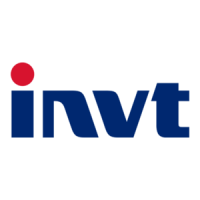What does external fault mean on INVT CHE100-004G/5R5P-4 DC Drives?
- RRachael WallaceSep 8, 2025
If the INVT DC Drive displays an external fault, it means the external fault input terminal is active. Inspect the external equipment.

What does external fault mean on INVT CHE100-004G/5R5P-4 DC Drives?
If the INVT DC Drive displays an external fault, it means the external fault input terminal is active. Inspect the external equipment.
What causes current detection fault in INVT DC Drives?
If the INVT DC Drive displays a current detection fault, it could be due to loose wires or connectors on the control board, a damaged Hall sensor, or an abnormal amplifying circuit. Check the wiring.
How to fix autotuning fault in INVT CHE100-004G/5R5P-4?
If the INVT DC Drive displays an autotuning fault, it could be due to improper settings of the motor's rated parameters or the autotuning process timing out. Set the rated parameters according to the motor nameplate and check the motor’s wiring.
What does EEPROM fault mean in INVT CHE100-004G/5R5P-4?
If the INVT DC Drive displays an EEPROM fault, it indicates a read/write fault of control parameters. Press STOP/RESET to reset.
What causes PID feedback fault in INVT CHE100-004G/5R5P-4 DC Drives?
If the INVT DC Drive displays a PID feedback fault, it could be due to a disconnected PID feedback or a disappearing PID feedback source. Inspect the PID feedback signal wire and the PID feedback source.
How to troubleshoot brake unit fault in INVT CHE100-004G/5R5P-4 DC Drives?
If the INVT DC Drive shows a brake unit fault, it could be due to braking circuit failure, a damaged brake tube, or too low resistance of the externally connected braking resistor. Inspect the braking unit and replace the braking tube if necessary. Increase the braking resistance.
| Model | CHE100-004G/5R5P-4 |
|---|---|
| Power | 4 kW |
| Rated Power | 4 kW |
| Rated Output Current | 9 A |
| Output Current | 9 A |
| Control Method | V/F control, Sensorless Vector Control |
| Communication Interface | RS485 |
| Cooling Method | Forced Air Cooling |
| Protection Level | IP20 |
| Enclosure Rating | IP20 |
| Output Voltage | 0~Rated Input Voltage |
| Protection Features | Overcurrent, overvoltage, undervoltage, overheat, short circuit |
Details basic functions including control mode selection and run command source.
Explains parameters related to starting and stopping the motor, including DC braking.
Covers parameters essential for motor identification and performance optimization, like rated power and resistance.
Describes parameters for vector control, including ASR proportional and integral gains.
Details parameters for V/F control, such as V/F curve selection and torque boost.
Explains the configuration and functions of the inverter's input terminals (S1-S4).
Details the functions and selection of output terminals (Y, ROA, ROB, ROC) for signaling.
Covers parameters related to the display interface, such as user password and language selection.
Describes advanced functions like skip frequency, traverse operation, and FDI settings.
Explains PID control parameters for process automation, including preset and feedback sources.
Details parameters for multi-step speed control, allowing predefined speed changes.
Covers various protection functions, including motor overload and stall protection.
Explains parameters for serial communication, including Modbus protocol settings.
Describes supplementary functions like oscillation restraint and PWM mode selection.
Provides a table of fault codes, types, reasons, and solutions for troubleshooting.
Lists common operational faults and their corresponding solutions for quick resolution.
Lists and describes basic function parameters (P0.00-P0.14) for initial setup.
Lists and describes parameters for controlling motor start, stop, and braking behavior (P1.00-P1.12).
